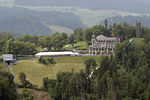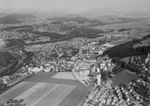Gurten Funicular
1899 establishments in SwitzerlandFunicular railways in SwitzerlandKönizMetre gauge railways in SwitzerlandRailway lines opened in 1899 ... and 1 more
Transport in Bern

The Gurten Funicular (German: Gurtenbahn) is a funicular railway in the southern suburbs of the Swiss capital city of Bern. The line links Wabern, in the municipality of Köniz, with the summit of the Gurten mountain (858 m), which overlooks the city of Bern. Wabern can be reached from the city centre by tram, train or car. Wabern bei Bern station, on lines S3 and S31 of the Bern S-Bahn, is adjacent to the lower station of the Gurtenbahn, as is the Gurtenbahn stop on Bern tramway route 9.The line is owned and operated by the company Gurtenbahn Bern AG.
Excerpt from the Wikipedia article Gurten Funicular (License: CC BY-SA 3.0, Authors, Images).Gurten Funicular
Grünenbodenweg,
Geographical coordinates (GPS) Address Nearby Places Show on map
Geographical coordinates (GPS)
| Latitude | Longitude |
|---|---|
| N 46.923831 ° | E 7.443023 ° |
Address
Grünenbodenweg
Grünenbodenweg
3095 , Spiegel
Bern, Switzerland
Open on Google Maps







